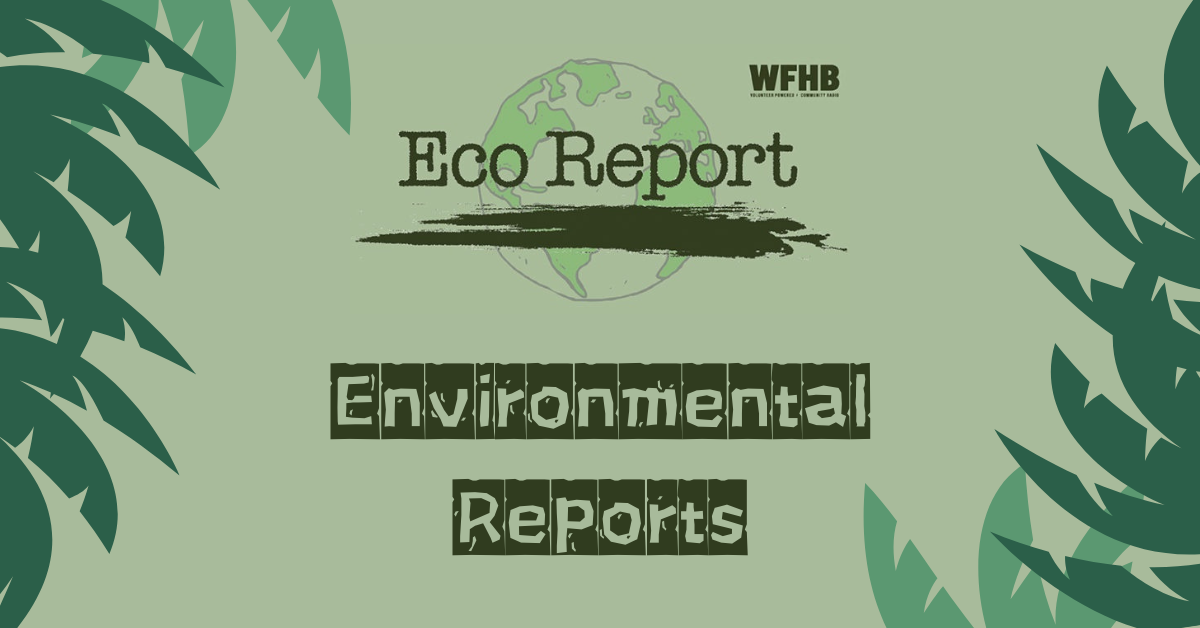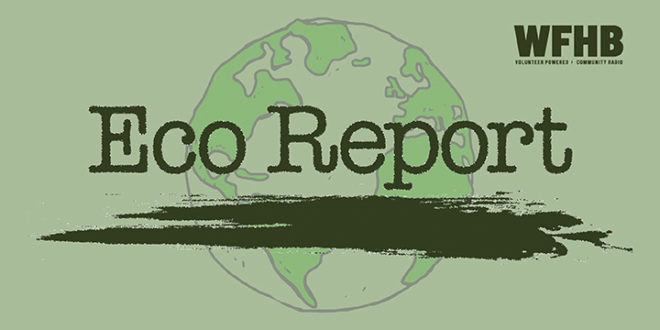Podcast: Play in new window | Download (Duration: 29:58 — 41.2MB)
Subscribe: RSS
You’re listening to Eco Report for Friday, February 2, 2024.
Later in the program, Environmental Correspondent Zyro Roze gets a breakdown of some bills currently before the Indiana House and Senate in Part One of his conversation with Sam Carpenter, the new Executive Director of the Hoosier Environmental Council.
And now for your environmental reports:

To help Indiana schools celebrate Earth Day 2024, the Indiana Department of Environmental Management is offering free hands-on classroom presentations to elementary students across the state. Every year, IDEM staff visit schools to talk about their careers and share STEM-based lessons on air, land, water, and recycling.
“I am pleased to have IDEM staff visit classrooms to work with Indiana’s leaders of tomorrow. Our STEM-based lessons are a great way to emphasize the importance of taking care of our environment while also introducing them to environmental-related careers,” said IDEM Commissioner Brian Rockensuess. “I hope Indiana’s teachers will take advantage of this great opportunity!”
Classroom Earth Day presentations are available for elementary schools and vary in length from 30 to 50 minutes. The interactive presentations offer activities such as reduce, reuse, recycle your trash, how long does your trash last, or a demonstration on how water flows through a watershed.
In-person classroom presentations are available on a first-come, first-served basis throughout the month of April, and each school may request up to four presentations. Registration is now open. Teachers can request a classroom presentation by visiting on.IN.gov/IDEMclassroom
—Indiana Department of Environmental Management
The UPI reports obtaining financial relief following more frequent natural disasters in an era of climate change will be easier under new guidelines published recently, the Biden administration says.
U.S. officials say people impacted by natural disasters should now have an easier time obtaining help through the Federal Emergency Management Agency’s Individual Assistance program, which includes financial assistance to help pay for lodging, food, and other necessities following a natural disaster.
(quote)The limitations of federal assistance have delayed disaster recovery for too many — especially communities that are disproportionately affected by disasters,(end quote) Secretary of Homeland Security Alejandro Mayorkas said in a statement last Friday.
FEMA administrator Deanne Criswell said the changes are the most significant program updates in 20 years and eliminate red tape to make it easier for individuals to obtain services, resources and support when natural disasters occur.
Mayorkas and Criswell said more frequent extreme weather events caused by climate change made it necessary to update and streamline the system so disaster survivors have faster and easier access to needed resources.
FEMA removed prior loan application requirements to obtain certain types of financial assistance through the Small Business Administration and other federal agencies and programs. Now, disaster survivors can apply for financial help from FEMA and the SBA at the same time.
FEMA also will pay up to $42,500 to households for costs not covered by insurance, including deductibles and losses that exceed insurance limits. The financial help is in addition to insurance payments that might be made to cover insured losses due to a natural disaster. FEMA previously would not help those who received at least $42,500 in settlement funds from insurers.
The United States endured 28 natural disasters that totaled more than $1 billion in damages in 2023, the National Oceanic and Atmospheric Administration reported. Other disasters also occurred, including drought in the South and Midwest that caused about $14.5 billion in damages, CNN reported.
—Norm Holy
How Much Ice Is Greenland Losing? Researchers have found an Answer.
The island is shedding 20 percent more than previously estimated, a study found, potentially threatening ocean currents that help to regulate global temperatures.
Greenland’s expansive ice sheet is known to be shrinking, especially since the 1990s, because of warming from climate change. It’s a fate shared by the Antarctic Ice Sheet as well as glaciers around the world. Now, a new study reveals that about 20 percent more of the Greenland ice sheet has disappeared than previous estimates show.
The missing ice has been breaking and melting from the ends of glaciers around Greenland’s perimeter. The new research, published Wednesday in the journal Nature, provides a detailed accounting of a process that scientists knew was happening but had struggled to measure comprehensively.
“Almost every glacier in Greenland is retreating. And that story is true no matter where you look,” said Chad Greene, a glaciologist at the NASA Jet Propulsion Laboratory and the lead author of the study. “This retreat is happening everywhere and all at once.”
Because the ends of these glaciers generally sit below sea level, within deep fjords, their retreat isn’t directly adding a significant amount to sea level rise. But melting ice still adds an influx of freshwater that has implications for global climate models and projections, and for the system of ocean currents that regulates temperatures on both sides of the Atlantic Ocean.
Dr. Greene’s team combined more than 200,000 observations of glacier end points, covering almost all of Greenland, based on satellite images taken from 1985 to 2022. The researchers used observations from existing public data sets and combined them to create a comprehensive bird’s-eye view of the contracting edges of Greenland’s ice sheet over the past 40 years.
Earlier estimates of the changing size of Greenland’s ice sheet were based on three types of measurements: the altitude of the sheet’s surface, the velocity of ice passing by fixed locations and the gravitational pull produced by the sheet’s mass.
Combining several of these estimates, scientists arrived at a consensus that Greenland has lost a total of nearly five trillion metric tons of ice since 1992.
—Norm Holy
Feature Report:

And now, we turn to Zyro Roze and Sam Carpenter of the Hoosier Environmental Council as they discuss the ongoing Legislative Session at the State Capitol and proposed laws relating to wetlands, wild lands, lead testing and lead service lines.

Ways To Get Involved:
Are you looking for a way to make a difference on environmental issues?
Here at EcoReport we are currently looking for reporters, engineers, and segment producers. Our goal is to report facts on how we’re all affected by global climate disruption and the ongoing assaults on our air, land and water. We also celebrate ecologists, tree huggers, soil builders and an assortment of champions who actively protect and restore our natural world, particularly those who are active in south central Indiana.
All levels of experience and all ages are welcome, and we provide the training you’ll need. W-F-H-B also offers internships.
To volunteer for Eco-Report, give us a call at (812) 323-1200, or e-mail us at: [email protected].

- “Eagles Over Monroe” is an annual event that celebrates Monroe Lake’s unique history with the Bald Eagle. The event begins on Thursday, February 1st and runs through Sunday, February 4th with special activities planned for each day. Go to bit.ly/eom2024 to get the full schedule.
- Brown County State Park continues their Winter Hike Series with The Lake That Never Was hike on Saturday, February 3rd, from 11 am to 1:30 pm. Hike to the Taylor Hollow Lake to see the 3rd lake in Brown County that was started and never completed. This is a 2.5 mile, rugged hike. Wear water proof shoes and dress for the weather.
- The Whooper Wednesdays will continue at Goose Pond Fish and Wildlife Area until February 21st. Come to the Visitors Center on Wednesday, February 7th, at 8 am to walk the property and see if you can spot some of the resident birds, including the endangered Whooping Crane. Make sure to dress for the weather.
- A Winter Exploration Hike at Allens Creek State Recreation Area at Monroe Lake is scheduled for Wednesday, February 7th, from 1:30 to 3:30 pm. These hikes feature off-trail hiking through lesser-known areas of Monroe Lake. There is no “set” path and no planned route. There are no formal toilet facilities. Register at bit.ly/weh-feb7-2024.
- Learn about the Earth’s Most Venomous Snakes at Brown County State Park on Friday, February 9th, from 4 to 4:45 pm in the Nature Center. Indiana has 4 species of venomous snakes. You will learn how Indiana’s venomous snakes compare to the rest of the world.
Credits:
This week’s headlines were written by Norm Holy and the Indiana Department of Environmental Management
Today’s news feature was produced Zyro Roze and edited by Kade Young.
Julianna Dailey assembled the script which was edited by the EcoReport team.
Julianna Dailey compiled our events calendar.
Kade Young and Noelle Herhusky-Schneider produced today’s show.
Branden Blewett is our engineer.
Anchors are Julianna Dailey and Robert Shull.
 WFHB Bloomington Community Radio
WFHB Bloomington Community Radio


